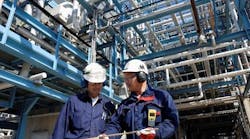Ethernet nodes in process industries are set to nearly double from 2011 to 2016, as the technology increasingly challenges fieldbus for leadership in the industrial networking market, according to a new study from IHS Inc.
Industrial Ethernet nodes in process industries are projected to rise to 8.7 million units in 2016, up 96 percent from 4.4 million in 2011, as presented in Figure 1. This means that industrial Ethernet will account for 45 percent of networked nodes connected in process industries in 2016, up from 39 percent in 2011. Such growth will come at the expense of fieldbus, anticipated to expand at a rate of 51 percent during the same five-year period.
“The process industry is renowned for being slow to adopt new technology,” Tom Moore, analyst for industrial Ethernet and fieldbus technologies at HIS, said in a prepared statement. “However, in some key areas, industrial Ethernet adoption is beginning to overtake fieldbus as the mainstream networking technology.”
A good example within the process sector is safety. Although not always driven by compulsory legislation, process safety systems—i.e., safety integrated systems—are updated fairly regularly by companies that want to ensure operator safety and maximize line uptime. This shorter life cycle means that new technologies can break into the market more quickly and are easier to implement, as there is greater opportunity for refreshing the network upon refitting.
Make Sure You’re Connected
“There is also a move to greater connectivity,” Moore said. “Networking is becoming more of a commodity, which means that remote monitoring and control is more accessible. This is also true of discrete automation.”
Process components and systems, such as remote terminal units and distributed control systems, are already widely networked. Approximately 95 percent of new-unit shipments are projected to be network enabled in 2016, up from 90 percent in 2011. “The increase is projected to be relatively slow, but is likely to reach 100 percent. Network-enabling products are now almost seen as a commodity and are expected by the process industry. As networking ability increases, the number of average nodes is also increasing. This enables the use of more elaborate networks and topologies,” Moore said.
The use of industrial Ethernet is expected to grow across industrial automation. IHS projects a compound annual growth rate (CAGR) of just north of 14 percent to 2016 for new process-automation networked nodes. The growth rate is well above that for new fieldbus nodes, envisioned to be less than 9 percent to 2016.
As adoption of industrial Ethernet increases in process industries, it seems that an industrial Ethernet-based network is a wise choice for those looking to upgrade networking infrastructure in the near future, IHS says. While fieldbus adoption is still growing, several advantages from industrial Ethernet can be enjoyed, including unification and simplification of networks that can result in lower costs and greater uptime.
Still, fieldbus has some advantages. HART, a big part of process industries, is able to overlay signals on 4-20mA wiring, a major advantage for those with existing infrastructure. There is also the sizable legacy of some fieldbus solutions, which means that a large amount of machinery still uses older protocols.
IHS says while industrial Ethernet will have to overcome these hurdles, it is forecast to have largely replaced fieldbus in many applications in the last 10 to 15 years. Reduced overheads, more accessible production data and decreased downtime are major advantages that will drive adoption of industrial Ethernet in the longer term.
“The World Market for Industrial Ethernet and Fieldbus Technologies – 2013 Edition” is now available from IHS. The report includes analysis of industrial Ethernet and fieldbus technologies.



